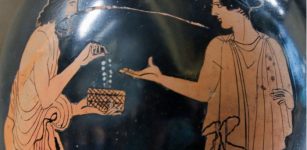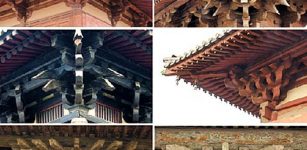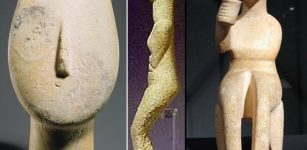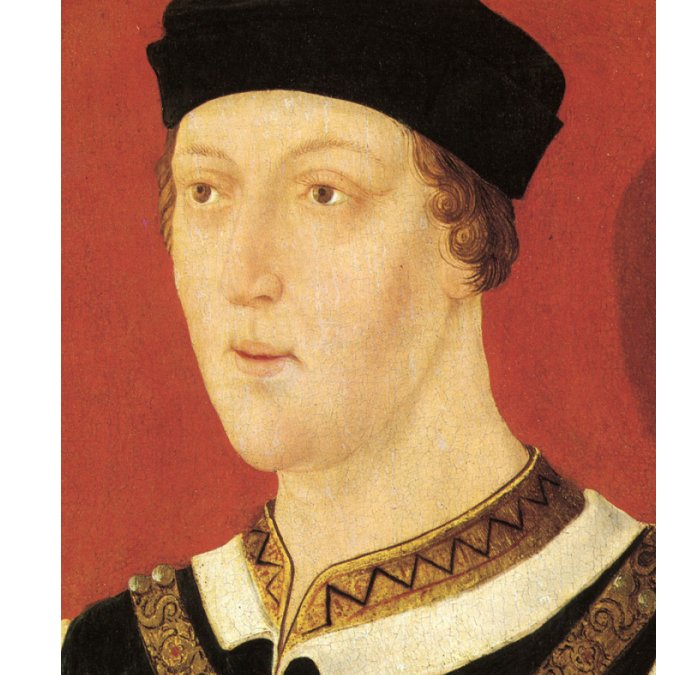Wars Of The Roses: Thirty Two Years Of Struggle To Claim English Throne
A. Sutherland - AncientPages.com - The Wars of the Roses was a civil war in England that lasted from 1455-1487. This thirty-two-year military conflict was fought between the supporters of the House of Lancaster (Lancastrians) and the supporters of the House of York (Yorkists).
Finding Richard's circlet after the battle, Lord Stanley hands it to Henry at the Battle of Bosworth Field, 1485. Engraving, 19th century. Image via Warfare History Network
The name of the wars is related to the roses; a red rose represents the Lancastrians (House of Lancastrians) and the Yorkists by a white rose.
It was a struggle to claim the right to the English throne, and each side sincerely believed they had a rightful claim. The Lancastrians and the Yorkists were two of England's most influential great aristocratic families.
Another important figure in this conflict was an English nobleman, administrator, and military commander, Richard Neville, 16th Earl of Warwick (1428 – 1471). He was wealthy and powerful, with political connections beyond the country's borders.
Neville was initially on the Yorkist side but later switched to the Lancastrian side, and in fact, he was instrumental in the deposition of two kings.
The dispute between the two houses began with the overthrow of King Richard by Henry Bolingbroke, Duke of Lancaster, in 1399. Henry Bolingbroke ( c. April 1367 – 20 March 1413), crowned Henry IV, was King of England from 1399 to 1413, but his rule was widely unpopular. Shortly, a revolt broke out in Wales, Cheshire, and Northumberland, and Henry IV managed to suppress the revolts with difficulty.
He died in 1413, and his successor was Henry V, a popular king and a strong leader who led England against France in the Hundred Years' War (1337 to 1453) and won many battles, giving the Lancastrians enough power to hold on to the throne. When Henry V died in 1422 from dysentery, his son, Henry VI, became his successor as King of England and France, but he had many difficulties in ruling the country. He had a mental illness inherited from his French grandfather, Charles VI.
Henry was an ineffective ruler, surrounded by some unpopular advisors such as Cardinal Beaufort, the Duke of Gloucester, and the Duke of Suffolk When Henry VI's life was about to end, the Yorkists were almost sure their representative would have a right of succession after him.
Henrik VI (1421-1471), Image credi: Anonymous - Public Domain
However, it was not that simple. The new King did not inherit the throne; instead, he was elected. Parliament played an essential role in this challenging political process. It had the enormous power to create a king.
"..Haughty, arrogant kings bowed submissively to its will. Henry could not make laws nor impose taxes without first summoning Parliament and obtaining his subjects' consent. But corrupting influences were at work, which was destined to cheat England out of her liberties for many a year." 1
The country's impoverishment to pay for the war and royal extravagances had awakened a troublesome spirit in the House of Commons. Cruelty to heretics also, and oppressive enactments were fought and defeated in this body. The Kikingclergy, and nobles, were drawing closer together and farther away from the people, and were devising ways of stifling their will…" wrote an American author and historian, Mary Platt Parmele, in her "A Short History of England, Ireland, and Scotland."
At the same time, according to the strict rules of hereditary succession, there were two others with claims superior to Henry's. The Duke of Lancaster, Henry's father (John of Gaunt), was only a younger son of Edward III. Richard Duke of York, his cousin, claimed a double descent from Duke Clarence and the Duke of York, both sons of Edward III.
It is also said that another immediate cause of the York revolt related to Queen Margaret Anjou, who unexpectedly revealed her male child. It had raised serious doubts about the origin of the righteous bed and, of course, seriously contributed to the beginning of the Wars of the Roses, a gloomy and very destructive period in the history of England, where most of the fighting took place, which resulted in significant loss of life and property.
"…Murders, executions, treacheries, adorn a network of intrigue and villainy, … was enough to have made the "White" and the "Red Rose" forever hateful to English eyes."
Many more significant battles and minor clashes occurred between the fighting parts; however, the last and decisive battle military encounter is known as the Battle of Bosworth Field (or Battle of Bosworth).
Henry VII (1457 – 1509), an offshoot of the House of Lancaster), raised a Lancastrian army against Richard III, defeated the Yorkists, and killed Richard at the Battle of Bosworth Field in 1485.
After this battle, the throne of England finally fell to the representative of a strong family - Henry Tudor.
Henry VII was crowned King and married Edward IV's daughter, Princess Elizabeth of York - a move to end the very tiring and devastating period in the history of England - Wars of the Roses. He reunited the two royal houses, merging the rival symbols of the red and white roses into the new emblem of the red and white Tudor rose.
The House of Tudor ruled the Kingdom of England until 1603.
Written by – A. Sutherland AncientPages.com Staff Writer
Updated on October 2, 2022
Copyright © AncientPages.com All rights reserved. This material may not be published, broadcast, rewritten or redistributed in whole or part without the express written permission of AncientPages.com
Expand for referencesReferences:
- Mary Parmele, History of England
More From Ancient Pages
-
 Choctaw Indians’ Legend Of Nanih Waiya Cave Mound – Mysterious Underground Realm Of Their Ancestors And Their Battle With Giants
Ancient Mysteries | Aug 3, 2017
Choctaw Indians’ Legend Of Nanih Waiya Cave Mound – Mysterious Underground Realm Of Their Ancestors And Their Battle With Giants
Ancient Mysteries | Aug 3, 2017 -
 Large Ancient Statues And Artifact With Foreign Inscription Found In A Swamp In Michigan
Featured Stories | Oct 13, 2024
Large Ancient Statues And Artifact With Foreign Inscription Found In A Swamp In Michigan
Featured Stories | Oct 13, 2024 -
 Necklace Of Harmony – Powerful Ill-Fated Piece Of Jewelry With Curse
Featured Stories | Jul 3, 2021
Necklace Of Harmony – Powerful Ill-Fated Piece Of Jewelry With Curse
Featured Stories | Jul 3, 2021 -
 DNA Says You’re Related To A Viking, A Medieval German Jew Or A 1700s Enslaved African? What A Genetic Match Really Means
DNA | Jun 7, 2024
DNA Says You’re Related To A Viking, A Medieval German Jew Or A 1700s Enslaved African? What A Genetic Match Really Means
DNA | Jun 7, 2024 -
 Beautiful Mosaics In 1,300-Year-Old Church Discovered In The Lower Galilee
Archaeology | Aug 29, 2020
Beautiful Mosaics In 1,300-Year-Old Church Discovered In The Lower Galilee
Archaeology | Aug 29, 2020 -
 Ancient Secrets Of Dougong Brackets: How 2,500-Year-Old Buildings Could Survive Earthquakes
Ancient History Facts | Jul 31, 2017
Ancient Secrets Of Dougong Brackets: How 2,500-Year-Old Buildings Could Survive Earthquakes
Ancient History Facts | Jul 31, 2017 -
 Beer Was Used As Medicine And Payment In Ancient Egypt
Ancient History Facts | Feb 11, 2018
Beer Was Used As Medicine And Payment In Ancient Egypt
Ancient History Facts | Feb 11, 2018 -
 Scientists Caution Against Over-Interpreting Influence Of Climate On Cultural Change And Catastrophe
Archaeology | Aug 18, 2022
Scientists Caution Against Over-Interpreting Influence Of Climate On Cultural Change And Catastrophe
Archaeology | Aug 18, 2022 -
 The Cyclades And Their Mysterious Society Lost In Time
Civilizations | Feb 4, 2016
The Cyclades And Their Mysterious Society Lost In Time
Civilizations | Feb 4, 2016 -
 Tuatha de Danann – ‘Gods’ Of Ireland And The Myth Of Danae And Zeus – Could The Early Irish Celts Have Ties To Ancient Greece?
Ancient Mysteries | Mar 28, 2017
Tuatha de Danann – ‘Gods’ Of Ireland And The Myth Of Danae And Zeus – Could The Early Irish Celts Have Ties To Ancient Greece?
Ancient Mysteries | Mar 28, 2017 -
 Ancient Symbol Hamsa: It’s Meaning And History Explained
Ancient Symbols | May 20, 2020
Ancient Symbol Hamsa: It’s Meaning And History Explained
Ancient Symbols | May 20, 2020 -
 Early, Complex Brain Surgery Performed In Ancient Greece
Archaeology | Apr 8, 2020
Early, Complex Brain Surgery Performed In Ancient Greece
Archaeology | Apr 8, 2020 -
 Amazing Giant Rock Engravings Discovered In South America May Be The World’s Largest
Archaeology | Jun 5, 2024
Amazing Giant Rock Engravings Discovered In South America May Be The World’s Largest
Archaeology | Jun 5, 2024 -
 Keeladi Ancient Site Of Tamil Nadu – A Punch-Marked Silver Coin Unearthed
Archaeology | Jul 31, 2021
Keeladi Ancient Site Of Tamil Nadu – A Punch-Marked Silver Coin Unearthed
Archaeology | Jul 31, 2021 -
 Remarkable South-Pointing Chariot – Ancient Cybernetic Machine Invented 1,700 Years Ago Is An Engineering Masterpiece
Ancient Technology | Jul 17, 2014
Remarkable South-Pointing Chariot – Ancient Cybernetic Machine Invented 1,700 Years Ago Is An Engineering Masterpiece
Ancient Technology | Jul 17, 2014 -
 Rare 17th Century Wreck Of Dutch Fluit Ship Found In The Baltic Sea By Finnish Divers
News | Aug 25, 2020
Rare 17th Century Wreck Of Dutch Fluit Ship Found In The Baltic Sea By Finnish Divers
News | Aug 25, 2020 -
 Why Are Christmas Ghost Stories So Fascinating?
Christmas Traditions | Dec 24, 2019
Why Are Christmas Ghost Stories So Fascinating?
Christmas Traditions | Dec 24, 2019 -
 Don’t Underestimate The Rishis – Ancient Sages Were ‘Probably Great Scientists’
News | Sep 26, 2015
Don’t Underestimate The Rishis – Ancient Sages Were ‘Probably Great Scientists’
News | Sep 26, 2015 -
 Moses’ Secret Knowledge Of Superior And Forbidden Technology – Alien Intervention And Events Erased From Historical Records – Part 2
Ancient Mysteries | Sep 24, 2020
Moses’ Secret Knowledge Of Superior And Forbidden Technology – Alien Intervention And Events Erased From Historical Records – Part 2
Ancient Mysteries | Sep 24, 2020 -
 The Oseberg Tapestry And Other Artifacts Show Intense Colors Were A Viking Symbol Of Status And Wealth
Featured Stories | Sep 27, 2021
The Oseberg Tapestry And Other Artifacts Show Intense Colors Were A Viking Symbol Of Status And Wealth
Featured Stories | Sep 27, 2021



